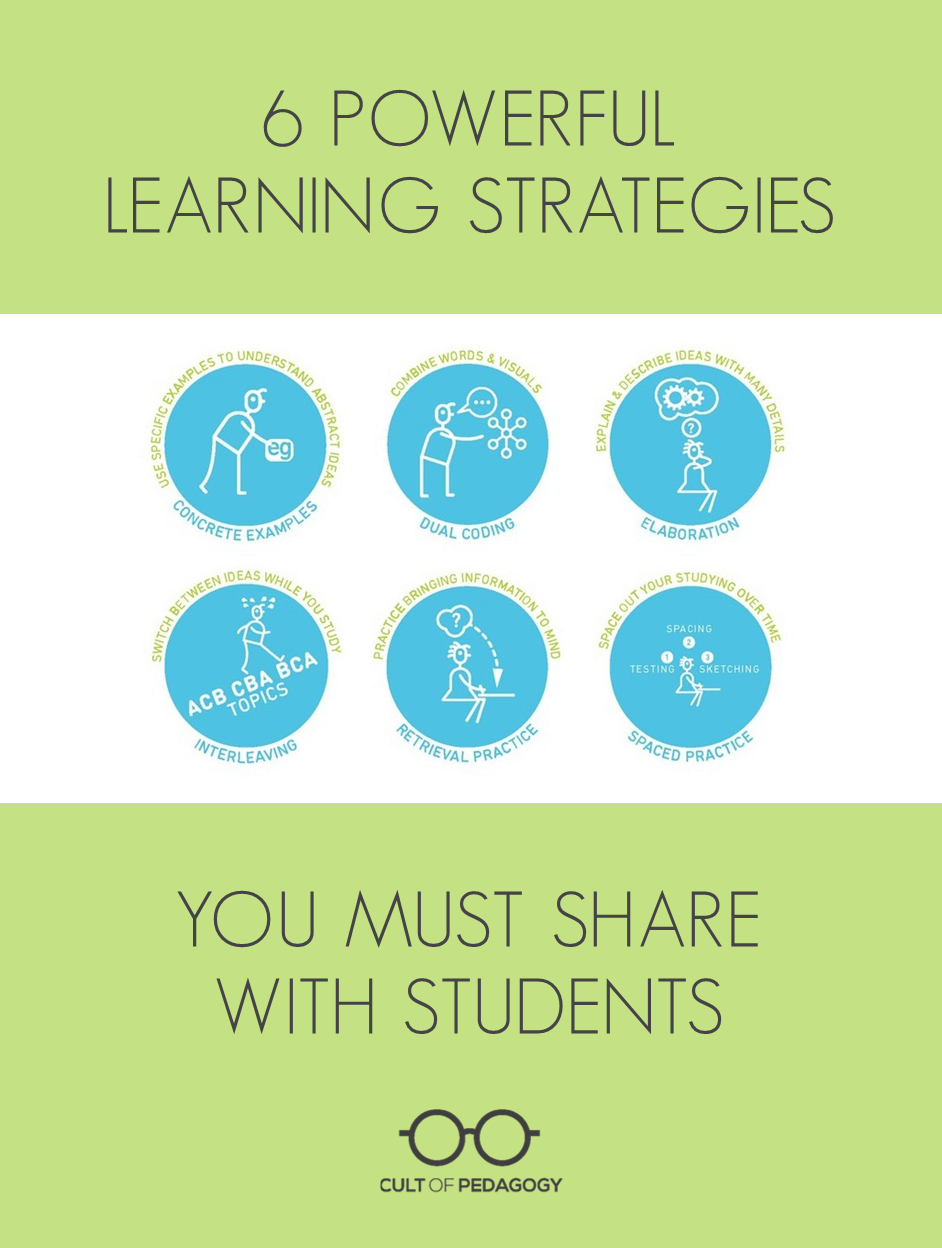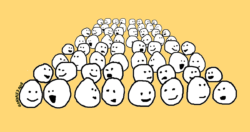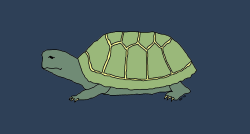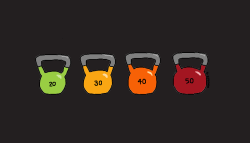
Interview with Megan Smith and Yana Weinstein ( transcript):
What does the word “study” mean to you?
Have you ever told your students to study for a test? Have you ever actually taught them how to study?
It turns out studying can be taught. And two cognitive psychological scientists, Yana Weinstein and Megan Smith (whose name has changed since this post to Sumeracki), have made it their mission to teach people how to study better. On their new website, The Learning Scientists, they use infographics and videos to share strategies and other insights about how we learn.

Here we will explore six research-based learning strategies that Weinstein and Smith teach on their site. If we can work these methods into our instruction, and teach students how to use them on their own, our students stand a much better chance of actually remembering our material.
One final note before we dig in: Although performance assessments and project-based learning allow students to show what they know with more depth and authenticity, most content areas still need to measure some learning with tests. When you are teaching that kind of content, these six strategies will help your students perform better on the test AND retain that information long after the test is over.
1. Spaced Practice
Space out your studying over time.
Far too many students wait until the night before a test to study for it. Similarly, teachers often wait until the day before a test to review. When enough students score well on the test, it appears they have learned the material. But a few weeks later, most of that information has vanished from students’ minds. For more durable learning, the studying has to take place in smaller chunks over time.
“Every time you leave a little space, you forget a bit of the information, and then you kind of relearn it,” Weinstein explains. “That forgetting actually helps you to strengthen the memory. It’s kind of counterintuitive, but you need to forget a little bit in order to then help yourself learn it by remembering again.”
Teachers can help students apply this strategy by helping them create a studying calendar to plan out how they will review chunks of content, and by carving out small chunks of class time every day for review. In both cases, plan to include current concepts AND previously learned material: Many teachers know this as “spiraling.”
2. Retrieval Practice
Practice bringing information to mind without the help of materials.
Many people think of “studying” as simply re-reading notes, textbooks, or other materials. But having the information right in front of us doesn’t force us to retrieve it from memory; instead, it allows us to trick ourselves into thinking we know something. Recalling information without supporting materials helps us learn it much more effectively.
“Put your class materials away, and then write out or maybe sketch or speak everything you know and try to be as thorough as possible, and then check your materials for accuracy,” Smith advises. “You’re bringing information to mind almost like you’re testing yourself; though it can be a practice test, it doesn’t have to be. You can just sort of go through and explain what you know, or teach a friend or a pet or even an inanimate object everything that you learned in school. By bringing that information to mind, you’re changing the way that information is stored so that it’s easier for you to get to later on.”
Teach students how to do retrieval practice in class: Have them turn off their devices, put all their notes and books away, then ask them to write everything they know about a particular term or topic, or share their thoughts in a think-pair-share. When the practice is done, have students check their understanding by revisiting their materials and discussing misconceptions as a class. Once they learn how to do this in school, they can then apply it at home.
3. Elaboration
Explain and describe ideas with many details.
This method asks students to go beyond simple recall of information and start making connections within the content. Students should ask themselves open-ended questions about the material, answer in as much detail as possible, then check the materials to make sure their understanding is correct.
Here’s how Smith and Weinstein explain elaboration:
Teachers can apply this strategy by having brief class discussions where these kinds of questions are explored and asking students to work elaboration into their own study plans.
4. Interleaving
Switch between ideas while you study.
Common knowledge tells us that to learn a skill, we should practice it over and over again. While repetition is vital, research says we will actually learn that skill more effectively if we mix our practice of it with other skills. This is known as interleaving.
“Let’s say you’re doing a bunch of math problems,” Weinstein says. “What’s fairly typical is … five of the same problem, or 10 of the same problem. Instead of doing that, try different problems in different orders.” So if students are learning to calculate the area of a triangle, instead of having them do 20 problems with triangles, have them do one of a triangle, then one of a circle, then a triangle, then a square.
“The thing about that,” Weinstein notes, “is that it’s actually harder. So they’ll be getting more wrong, they’ll be making more errors, but they’ll also be learning something very important, which is how to choose a particular strategy for each problem, as opposed to just repeatedly doing the same thing.”
When planning exercises for students, resist the temptation to have them repeat the exact same process multiple times in a row. Instead, have them do a few of the new process, then weave in other skills, so that the repetitive behavior is interrupted and students are forced to think more critically. Explain this strategy to students so they can apply interleaving to their own studying.
5. Concrete Examples
Use specific examples to understand abstract ideas.
Most teachers already use this strategy in their own teaching; it’s a natural part of explaining a new concept. But what we don’t necessarily do is help students extend their understanding by coming up with examples of their own. Here’s how Weinstein and Smith explain this broader use of concrete examples as a study practice:
Teachers can apply this strategy by using concrete examples when teaching abstract concepts, then asking students to come up with their own, correcting any examples (or parts of examples) that aren’t quite right, and looking for more. Encourage students to continue this practice when they study.
6. Dual Coding
Combine words and visuals.
When information is presented to us, it is often accompanied by some kind of visual: An image, a chart or graph, or a graphic organizer. When students are studying, they should make it a habit to pay attention to those visuals and link them to the text by explaining what they mean in their own words. Then, students can create their own visuals of the concepts they are learning. This process reinforces the concepts in the brain through two different paths, making it easier to retrieve later.
“And when we say visuals,” Smith explains, “we don’t necessarily mean anything specific, so it depends on the types of materials. You could have an infographic, a cartoon strip, a diagram, a graphic organizer, timeline, anything that makes sense to you so long as you’re sort of depicting the information both in a way with words and a way with pictures.”
“This isn’t just for students who are good at drawing,” Weinstein adds. “It’s not about the quality of the drawing. It really just needs to be a visual representation as you can depict it.”
In class, regularly turn students’ attention to the visuals used in textbooks, on websites, and even in your own slideshow presentations. Have students describe the visuals to each other and make connections with what you’re learning. Then have students create their own visuals of the content to further reinforce it. Remind students to include diagramming, sketching, and creating graphic organizers when they study at home.
Making the Most of the Strategies
Two more pieces of advice on how to maximize these strategies for learning:
Combine them. These strategies don’t necessarily work in isolation. You can space out your retrieval practice, and when doing retrieval practice, try to recall concrete examples, elaborate, or sketch out a concept. When doing retrieval practice, you can interleave between different concepts.
Make them part of your class vocabulary. If you just use these strategies in your teaching, you’ll see improvement. But if you actually explain the research to students, teach them the terminology, and use that terminology when teaching—”Okay, we’re going to spend a few minutes on retrieval practice”—students will not only have a clearer understanding of why you’re doing what you do, but they may be more likely to carry those skills with them into future classes.
Learn More
The Learning Scientists site is full of useful information about how people learn, and more is being added every week. To learn more, visit learningscientists.org, and to download this free chart and other materials about the strategies, click the image below.
Other resources mentioned on the podcast:
Learning Scientists on Twitter: @acethattest
Learning Scientists on Facebook: facebook.com/acethattest
Make It Stick, The Science of Successful Learning, by Brown, Roediger & McDaniel
Join my mailing list and get weekly tips, tools, and inspiration—in quick, bite-sized packages—all geared toward making your teaching more effective and fun. You’ll also get access to my members-only library of free downloadable resources, including my e-booklet, 20 Ways to Cut Your Grading Time in Half, which has helped thousands of teachers spend less time grading!






I can relate to the concepts of dual coding, details and elaboration. But the idea of retrieval without notes is new to me. I suppose it is the step away from rote memorization, along with the concept of interleaving. The concept of interleaving is not new to me, but I’m glad to have a name for “keeping students on their toes”, so to speak.
Thanks for reminding me of a memorable chat me and my son had concerning what it means to study for an upcoming spelling test. As teachers, we often forget how important it is to guide our students to see the “how” behind the learning process.
https://cookinupsomelearnin.wordpress.com/2017/03/18/galileo-you-cannot-teach-a-person-anything/
yes…your’e correct
I love the Learning Scientists and have been an advocate of spaced retrieval practice for some time now. Keep up the great work guys!
Have you done the Coursera “Learning How to Learn”?? It goes through most of these strategies and shares the brain research behind them. This is such a perfect summary of the skills, and I definitely plan to share this as a “preview” for the course!
Thank you this is a wonderful resource and so well done!
Just wanted to ask a question. Why don’t each school district make these learning/study procedure a part of everyday teaching strategies.
Great question, Robert! Wouldn’t that be great??
Hey Robert! That is exactly why I wanted to share these ideas here. Oftentimes we don’t use the most effective practices in the classroom simply because we aren’t aware of them. I’m trying to spread the word!
Hi Jennifer! Love the podcast … as a teacher of 30 years who is still trying to learn the trade, I deeply appreciate your multi-level approach to the art we are working on in the classroom.
At the beginning of this podcast, you mentioned a comic video(?) maker that I’d like to try. I’m not finding it in the podcast notes. Perhaps I’m missing something? Could you tell me that site again?
Hey Dawn,
This is Debbie Sachs, a Cult of Pedagogy Customer Experience manager. Check out My Simple Show — I think that’s what you’re looking for. Have fun!
Thank you very much for this podcast. I learned a lot and hope to learn even more. I have never heard of these concepts and will utilize as much as I can within my Special Ed. classroom.
I had a question about dual coding. I give my H.S. biology students the option of either drawing or finding an image on the internet to connect a visual to their vocabulary terms. Is the idea of dual-coding more about the actual drawing process or is it more about a student’s ability to connect the image they chose to the vocabulary terms? Does it matter if the image is hand-drawn versus one found on the internet?
Hi Wendy, I’m a Customer Experience Manager with Cult of Pedagogy. I think it’s definitely important to study and understand how images, graphics, charts, and other visuals that are featured with text are linked together. But, yes, brain research shows that the physical process of drawing or doodling has great impact on processing and retaining information. Sunni Brown’s The Doodle Revolution is a great resource to check out if you’re not already familiar with it. Hope this helps.
I’d say dual coding itself more about making the connection between the words and pictures. However, if the students have to make their own image or put together a number of smaller images, then this might allow you to see how well the students are actually understanding the material (rather than just finding one image and saying, here it is). Further, if you remove their class materials and ask them to draw from memory or put together a number of smaller pictures to create a bigger image from memory, then you’re combining retrieval practice with dual coding. Since retrieval practice is a really powerful way to promote learning, having the students work their way up to creating their own images from memory will be extra helpful! — Megan
A good example of dual coding is learning names, I’ve learned I need to pair the face with either text of name or verbal of name. Like if I don’t repeat that , then it dosent stick. But like I’m adhd and many of us and other people mind you say “I’m just bad with names” it’s like no your not, you just didn’t encode it to begin with. Your memory is fine. Hence why once I found a process todo this I would on first day camp program I had several sessions and could roughly learn 80 names in a day. but only because I had a system and integrated the story I had to tell that day into using their names and looking at them a few times. It worked out well. They understood what they needed, I figured out who they all were. Etc etc. But like this might just be a decent example for kids to remember for dual coding.
Smaller classes do not necessarily improve children’s performance. Asian countries such as South Korea and Singapore have considerably larger classes sizes but have excellent results. A lecture can be received just as well by 100 people as 10. Front of class teaching needs to be supplemented by textbook study after the lesson. This is what homework is all about. A time during the lesson may be allocated to questions from the class, and additional time might be spent in tutorial sessions outside the normal class schedule.
Of course the smaller the class the easier it is to maintain discipline. The problem arises where children of very different abilities are grouped together in a class. If the teaching level is set too low, the brightest ones will get bored and cease to pay attention. If it is set too high the less able will cease to follow and probably will become disruptive. The solution would seem to be to stream according to ability.
I am not very familiar with the education process in China. Is every child educated to the same minimum level, ie 12th grade, or is a split made earlier, depending upon ability?
In the U.S. every child must be educated until the age of 16 in most states, so class size does become an issue.
Thank you! I teach High School Spanish. I often incorporate these learning strategies into class activities. The problem I find, is that at home, students are cramming for quizzes & tests. How do I encourage students to “buy in” at home AND school?
here I would like more research to undesrtand of ways and effectiveness share it experiences classsroon action for beneficial students, so that I want to you inform you that please reply send back to me teaching strategies.
that,s all my aspiration to remended you
unforgetable thank you very much.
Hi Estevao! Check out the Teaching Strategies category on the site and the Classroom Instruction & Teaching Strategies Pinterest Board. Hopefully you’ll find some good stuff here!
thank you for efforts. please can you help me in writing a research about / learning strategies and learning methods / specially for – the English language teaching / thanks my dear.
Hi Ahmed,
Because I’m not exactly sure what you’re looking for, I suggest checking out the many English Learner resources on the site as well as Jenn’s Teaching English Learners board on Pinterest.
Great Strategy technique to informing students how to learn.
I am a college student and I was asked to research on types of teaching and learning. Can any one help me?
Yes, these learning strategies will help many a student, if informed to them and they practice well. It should go a long way in increasing the quality of learning..
I wish my teachers did something like this when I was a kid. If I was a teacher, I would do all of the things you listed here. That way, I can be sure that they would do well.
Thank you for this podcast which so clearly delineates best practices for teaching and learning to improve memory and study skills.
I’ve been working on improving my vocabulary for the last two months. I found that it was difficult to begin, but once I started, it became much easier. I try to do most of my vocabulary improvement through a lot of reading, searching, finding synonyms.
But recently I found a new app which is so helpful to learn new vocabulary and memorize it. the app has a lot of synonym whit correct Pronunciation, there are a few short films which show you how to use that particular word in Sentence.
Its call “WordUp”.
find it on : https://wordupapp.co
I am a Carpentry Tutor, at present doing my level 5 teaching Certificate.
This web-site has been very useful, even just the 6 learning strategies. Look forward to getting into this web site more in the future.
Can you please kindly define what is strategy (in the domain of pedagogy), and how the definition is applied, for example is it cover brainstorming or not (or brainstorming is a method?)
Hi Khaled! Good question. Think of a learning strategy as a way that we learn. Dual coding – making connections between text and visuals – is a learning strategy. Teaching strategies (methods) that could apply dual coding might be mind mapping, brainstorming, doodling, sketching, diagramming, etc. Another example: Retrieval practice is a learning strategy and a teaching strategy that applies to this could be a brain dump.
Hope this helps!
New to teaching, and enjoy reading this resource. My basic, almost existential question is this: 1. How do we know these techniques work? 2. If these techniques work, and we implement them well, should we expect constant measurable improvement? 3. Does this then mean that our constantly improving pedagogy guarantees measurable and constant improvement over time? My thought experiment…if the profession constantly improves, does this mean our students are x% better each year, and students today are 40x% better than they were 40 years ago?
I loved it. Thanks. As a teacher, I would like to get some information about teaching learning.
Hi! On the site we have a lot of Learning Theory articles that you might find helpful.
Thank you for this post! Many approaches are quite obvious to teachers, but there are also original and fresh ideas.
I like the main idea that it is possible to teach studying.
Repetition of what has been learned before and concrete examples of abstract things are really very useful methods, but simple ones. If you repeat the material studied not once, but several times (within a month or two), it will be better remembered. And associations of abstract with concrete help to better understand the material.
Of course, many methods can be mixed and applied holistically, and it will work even better. But the main thing that the student himself wanted to learn, otherwise no methods will not help.
Discussing what I have read with a friend by explaining it in my own terms without looking into the materials at first, and by also writing it down, then later checking it with the original materials for correction. This is because it has been proven that learning is effective and recalling information without supporting materials.
This is GREAT! Talks about general learning strategies for studying. The podcast is accurate, students do not learn HOW TO STUDY. This is never “assigned”. Those of us who study well have had to learn on our own what works for us. Those who aren’t good at studying, never learned on our own. GREAT PODCAST!
Great, for the learning style address
In stead of the science class, Physics high school. Would you please give some STEM education for teaching ?
Hi Rathana! We don’t have a specific place on the website for STEM resources, but we definitely recommend our STEM/STEAM & Makerspaces board on Pinterest. I hope this helps!
You may find ‘STEM learning’ (https://www.stem.org.uk/) and ‘Futurelearn STEM teaching courses’ (https://www.futurelearn.com/subjects/teaching-courses/teaching-science-technology-engineering-and-maths) useful; apologies if already aware! 🙂
I would be willing to try elaboration. The plan I would do is by brainstorming and gathering all my thoughts for the details.
I love this post! It’s so important to share these strategies with students.
We’re glad you enjoyed the post!
The learning strategies and procedures for study before a test. I like them all because they are creative ways to implement to help the students to facilitate their process of learning.
Glad you found them valuable, Silvia!